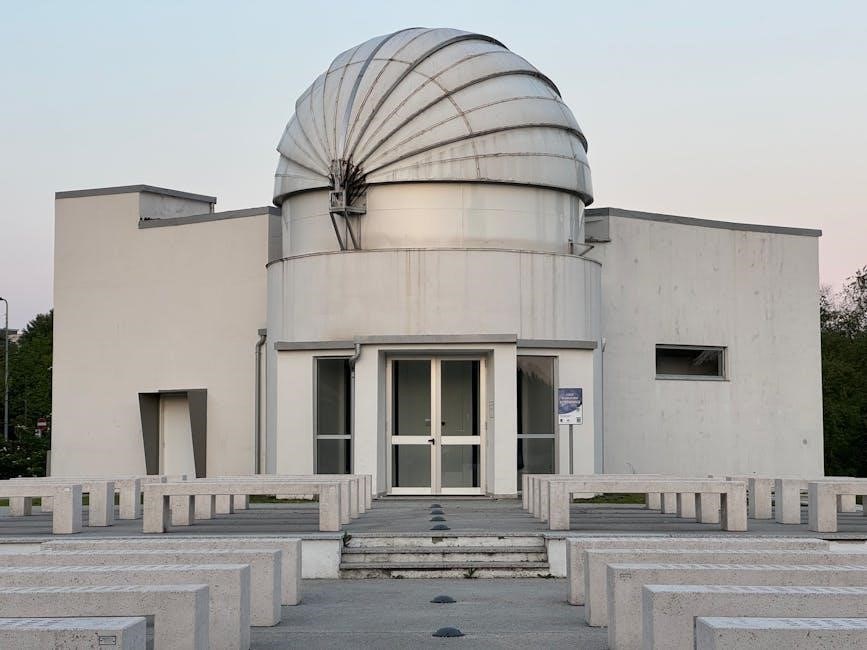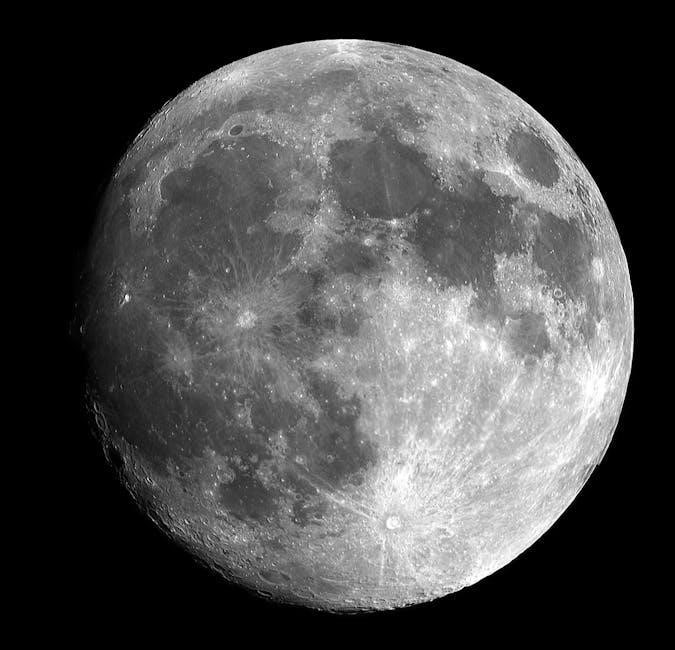Astronomy is the scientific study of celestial objects and phenomena. It explores the universe’s origins‚ structure‚ and evolution‚ captivating human curiosity and driving technological advancements.
1.1 What is Astronomy?
Astronomy is the scientific study of celestial objects‚ space‚ and the universe’s phenomena. It employs observations‚ experiments‚ and theoretical frameworks to explore cosmic structures‚ from stars and planets to galaxies and black holes. By understanding these elements‚ astronomy reveals the universe’s origins‚ evolution‚ and fundamental laws‚ inspiring technological advancements and expanding human knowledge of existence.
1.2 The Importance of Astronomy in Understanding the Universe
Astronomy is crucial for understanding the universe’s origins‚ structure‚ and evolution. It drives technological advancements‚ satisfies human curiosity‚ and reveals fundamental laws governing the cosmos. By studying celestial phenomena‚ astronomy addresses questions about the universe’s age‚ composition‚ and fate‚ ultimately enriching our understanding of existence and humanity’s place within the grand cosmic framework.

History of Astronomy
Astronomy’s history traces humanity’s quest to understand the cosmos‚ from ancient stargazing to modern space exploration‚ reflecting evolving knowledge and technological advancements over centuries.
2.1 Ancient Civilizations and Their Contributions to Astronomy
Ancient civilizations laid the foundation for astronomy through meticulous observations and recordings of celestial events. Babylonians created the Venus Tablets‚ while Greeks like Ptolemy developed geocentric models. Egyptians aligned pyramids with stars‚ and Mayans crafted precise calendars. These early efforts sparked curiosity and established methods for understanding the cosmos‚ influencing later scientific advancements.
2.2 The Renaissance and the Scientific Revolution in Astronomy
The Renaissance and Scientific Revolution transformed astronomy‚ shifting from ancient beliefs to empirical science. Nicolaus Copernicus proposed the heliocentric model‚ while Galileo Galilei’s telescope provided evidence for it. Johannes Kepler discovered planetary motion laws‚ and Isaac Newton formulated universal gravitation. These advancements laid the foundation for modern astronomy‚ emphasizing observation‚ experimentation‚ and mathematical analysis to understand the universe.
Key Concepts in Astronomy
Astronomy explores the universe through understanding the Solar System‚ stars‚ galaxies‚ and cosmology. These concepts reveal the structure‚ dynamics‚ and origins of celestial systems and phenomena.
3.1 The Solar System and Its Components
The Solar System consists of the Sun‚ eight planets‚ dwarf planets‚ asteroids‚ comets‚ and other celestial bodies. The Sun is the central star‚ while planets like Earth‚ Mars‚ and Jupiter orbit around it. The system also includes the Kuiper Belt and Oort Cloud‚ containing remnants from its formation. Understanding these components helps explain the Solar System’s structure‚ evolution‚ and place in the universe.
3.2 Stars‚ Galaxies‚ and Cosmology
Stars are massive celestial bodies sustained by nuclear fusion‚ while galaxies are vast systems of stars‚ gas‚ and dust. Cosmology explores the universe’s origin‚ structure‚ and fate‚ addressing questions about dark matter‚ dark energy‚ and cosmic expansion. These studies reveal the intricate dynamics of the cosmos‚ shaping our understanding of its evolution and the interconnectedness of celestial phenomena.

Astronomical Observations and Tools
Telescopes and space missions are crucial for observing celestial phenomena. They enable astronomers to study stars‚ planets‚ and galaxies‚ expanding our understanding of the universe’s dynamics and mysteries.
4.1 Telescopes and Their Role in Astronomy
Telescopes are essential tools in astronomy‚ enabling the observation of distant celestial objects. They collect light‚ allowing astronomers to study stars‚ galaxies‚ and planetary systems. From refracting to reflecting types‚ telescopes have revolutionized our understanding of the universe‚ facilitating groundbreaking discoveries like exoplanets and cosmic phenomena. Their advanced designs continue to expand humanity’s knowledge of space and its mysteries.
4.2 Space Missions and Their Contributions to Astronomy
Space missions have been pivotal in advancing astronomical knowledge. Missions like Hubble‚ Kepler‚ and JWST have provided unprecedented views of the cosmos‚ discovering exoplanets‚ mapping galaxies‚ and capturing stunning deep-space imagery. These endeavors have significantly expanded our understanding of the universe‚ enabling groundbreaking research and inspiring future exploratory efforts.
The Search for Extraterrestrial Life
The search for extraterrestrial life explores humanity’s curiosity about other life forms‚ driving scientific investigations into planetary habitability‚ biosignatures‚ and the potential for intelligent life beyond Earth.
5.1 The Possibility of Life Beyond Earth
The possibility of life beyond Earth is a compelling question in astronomy‚ with exoplanets and biosignatures offering clues. Discoveries of exoplanets in habitable zones and extremophiles on Earth suggest life might thrive under diverse conditions. While no definitive evidence exists‚ ongoing missions and advanced technologies continue to explore this mystery‚ keeping the hope alive for finding life elsewhere in the universe.
5.2 The Role of Astronomy in the Search for Extraterrestrial Intelligence (SETI)
Astronomy plays a vital role in SETI by providing the tools and methods to detect signals from extraterrestrial civilizations. Radio telescopes monitor the universe for intelligent signals‚ while optical telescopes search for laser pulses. Astronomical surveys analyze vast datasets to identify patterns that could indicate life. These efforts rely on advanced technology and collaboration‚ driving humanity’s quest to discover intelligent life beyond Earth and understand the cosmos’ potential for hosting civilizations.
Astronomy and Society
Astronomy deeply influences culture‚ sparking curiosity and inspiring innovation. It unites people worldwide‚ fostering education and outreach‚ while driving technological advancements that benefit society as a whole.
6.1 The Cultural Impact of Astronomy
Astronomy has profoundly shaped human culture‚ inspiring art‚ literature‚ and mythology. It has influenced philosophical thought‚ fostering curiosity and wonder. The study of the stars has also united societies‚ creating shared experiences and traditions. From ancient myths to modern media‚ astronomy continues to captivate imaginations‚ reflecting humanity’s deep connection to the cosmos.
Its cultural impact extends beyond science‚ inspiring innovation and exploration. It bridges generations‚ sparking a sense of cosmic citizenship and shared heritage. Astronomy’s influence on society is timeless‚ reminding us of our place in the universe and driving humanity’s quest for knowledge and discovery.
6.2 Astronomy Education and Outreach
Astronomy education fosters curiosity and understanding of the universe‚ engaging students and the public through interactive tools and resources. Outreach programs‚ such as stargazing events and online tutorials‚ make astronomy accessible to diverse audiences. Collaborations between institutions and communities promote learning and inspire future scientists‚ ensuring astronomy’s relevance and appeal across generations.
These initiatives bridge the gap between complex scientific concepts and public understanding‚ encouraging lifelong learning and exploration of the cosmos.
Future of Astronomy
The future of astronomy lies in cutting-edge technologies and collaborative missions‚ exploring dark matter‚ exoplanets‚ and cosmology. Advances in AI and space telescopes will deepen our cosmic understanding.
7.1 Upcoming Space Missions and Their Significance
Upcoming space missions‚ such as the James Webb Space Telescope and Euclid‚ will explore dark matter‚ dark energy‚ and distant galaxies. The Nancy Grace Roman Telescope will study exoplanets‚ while missions like the Square Kilometre Array (SKA) will probe the early universe. These missions leverage advanced technologies‚ including AI and high-resolution imaging‚ to uncover cosmic mysteries and expand humanity’s understanding of the universe.
7.2 Advances in Technology and Their Impact on Astronomy
Advances in technology‚ such as artificial intelligence‚ quantum computing‚ and high-resolution imaging‚ are revolutionizing astronomy. AI enhances data analysis and telescope operations‚ while quantum computing enables simulations of complex cosmic phenomena. High-resolution imaging captures unprecedented celestial details‚ and next-generation space telescopes provide clearer views of the universe. These innovations improve accuracy‚ efficiency‚ and our understanding of cosmic events‚ driving astronomical discoveries forward.
Resources for Learning Astronomy
Discover astronomy through recommended books‚ online courses‚ and interactive tools. Explore telescopes‚ star charts‚ and educational platforms like Google Trends for trending astronomical topics and data analysis.
8.1 Recommended Books and Research Papers
Explore foundational astronomy texts like “The Universe in a Nutshell” and “A Brief History of Time” for deep insights. Research papers on platforms like arXiv and NASA ADS provide cutting-edge discoveries. Classic works by pioneers such as Galileo and Kepler offer historical context‚ while modern journals detail advancements in astrophysics‚ cosmology‚ and planetary science‚ ensuring comprehensive learning.
8.2 Online Courses and Tutorials
Explore astronomy through online courses on platforms like Coursera and edX. These tutorials offer in-depth lessons on stargazing‚ planetary science‚ and astrophysics. Universities like Harvard and Caltech provide access to lecture materials and assignments. Additionally‚ NASA’s website offers interactive tools and educational resources‚ making it easier to learn about space exploration and cosmic phenomena from the comfort of your home.

Astronomy in Popular Media
Astronomy captivates audiences through documentaries like Cosmos and films like Interstellar‚ blending science with storytelling to inspire curiosity and wonder about the universe.
9.1 Documentaries and Films About Astronomy
Documentaries like Cosmos: A Spacetime Odyssey and The Universe series captivate audiences with stunning visuals and deep insights into celestial phenomena. Films such as Interstellar and Gravity blend science with storytelling‚ making astronomy accessible and inspiring. These productions spark curiosity and educate the public about the wonders of space‚ fostering a deeper appreciation for the cosmos and its mysteries.
9.2 Astronomy in Science Fiction
Science fiction often explores astronomical concepts‚ blending real science with imaginative storytelling; Works like Star Trek and Interstellar depict space travel‚ alien worlds‚ and cosmic phenomena‚ inspiring curiosity about the universe. These narratives often speculate on humanity’s future in space‚ influencing public perception and sparking interest in astronomy while entertaining audiences worldwide.
The Role of Amateur Astronomers
Amateur astronomers contribute significantly to the field by participating in citizen science projects‚ making discoveries‚ and promoting astronomy education through community outreach and public events.
10.1 Contributions of Amateur Astronomers to the Field
Amateur astronomers significantly contribute to the field by participating in citizen science projects‚ such as asteroid discoveries and variable star observations. They also support professional research through data collection and public outreach‚ fostering awareness and education. Their efforts often lead to notable findings‚ including comet discoveries and planetary observations‚ demonstrating the valuable role of enthusiasts in advancing astronomical knowledge and exploration.
10.2 How to Get Involved in Amateur Astronomy
Getting involved in amateur astronomy is accessible through local clubs‚ online forums‚ and community events. Start by investing in a telescope or binoculars and explore celestial objects. Attend star parties‚ join citizen science projects‚ and participate in astronomy workshops. Utilize free online tools like planetarium software to guide observations. Sharing discoveries and collaborating with others fosters a sense of community and enhances learning in this rewarding hobby.
Challenges in Astronomy
Astronomy faces challenges like limited funding‚ resource allocation issues‚ and ethical dilemmas‚ requiring careful management and innovation to advance our understanding of the cosmos effectively.
11.1 Funding and Resource Allocation
Funding and resource allocation pose significant challenges in astronomy‚ as securing sufficient financial support for large-scale projects remains competitive. Budget constraints often limit the scope and innovation of research initiatives‚ while ethical considerations arise in prioritizing resource distribution. These challenges require strategic planning and collaboration to ensure equitable access and maximize the impact of astronomical studies globally.
11.2 Ethical Considerations in Astronomy Research
Ethical issues in astronomy research encompass the responsible use of advanced technologies‚ ensuring data integrity‚ and avoiding biases in AI-driven analyses. Researchers must also address the ethical implications of space exploration‚ such as preventing planetary contamination and managing resource exploitation. Additionally‚ publication ethics‚ fair collaboration practices‚ and transparent funding sources are crucial to maintaining trust and integrity in astronomical studies.
Astronomy and Other Sciences
Astronomy intersects with physics‚ geology‚ and biology‚ offering insights into planetary formation‚ cosmic phenomena‚ and potential life beyond Earth‚ fostering interdisciplinary scientific advancements.
12.1 The Intersection of Astronomy and Physics
Astronomy and physics are deeply interconnected‚ as the study of celestial objects relies on physical principles like gravity‚ electromagnetism‚ and quantum mechanics. Physics provides the foundational theories and tools to understand phenomena such as black holes‚ cosmic expansion‚ and stellar dynamics. This synergy enables astronomers to explore the universe’s fundamental nature‚ from subatomic particles to galactic structures‚ bridging the micro and macro cosmos.
12.2 Astronomy and the Earth Sciences
Astronomy and Earth sciences intersect through the study of planetary climates‚ geological processes‚ and space weather. Observing other planets’ atmospheres and surfaces provides insights into Earth’s climate change and geological activity. Asteroid impacts and cometary arrivals have shaped Earth’s history‚ while solar flares and cosmic events influence our magnetic field and atmosphere‚ highlighting the interconnectedness of our planet with the cosmos.

Notable Astronomers and Their Discoveries
Astronomy has been shaped by the groundbreaking work of notable astronomers whose discoveries have illuminated the universe’s mysteries. Their contributions continue to inspire scientific exploration.
13.1 Pioneers in Astronomy
Astronomy’s foundation was laid by pioneers like Galileo Galilei‚ who first observed the heavens with a telescope‚ and Nicolaus Copernicus‚ who proposed the heliocentric model. Isaac Newton’s laws of motion and gravity revolutionized understanding of celestial mechanics. Johannes Kepler’s planetary laws provided crucial insights into orbital patterns. These visionaries’ discoveries transformed astronomy‚ laying the groundwork for modern astrophysical research and continuing to inspire future generations of scientists.
13.2 Modern Astronomers and Their Contributions
Modern astronomers like Neil deGrasse Tyson and Lisa Randall have advanced our understanding of the cosmos through groundbreaking research and public outreach. Their work in areas such as dark matter‚ exoplanet discovery‚ and gravitational wave detection has expanded humanity’s knowledge of the universe. These scientists continue to inspire new generations‚ blending cutting-edge technology with innovative thinking to unravel cosmic mysteries.

Astronomy and Technology
Technology has revolutionized astronomy‚ enabling deeper exploration of the universe. Advances in telescopes‚ space missions‚ and AI-driven analysis have transformed how we observe and understand celestial phenomena.
14.1 The Role of Computers in Astronomy
Computers have transformed astronomy by enabling advanced data processing‚ simulations‚ and telescope control. They facilitate complex calculations‚ image analysis‚ and large-scale data management. Tools like Google Trends and SEO strategies optimize research visibility‚ while AI-driven algorithms enhance pattern recognition in cosmic datasets‚ revolutionizing our understanding of the universe.
14.2 The Impact of Artificial Intelligence on Astronomy
Artificial intelligence (AI) has revolutionized astronomy by enhancing data analysis‚ pattern recognition‚ and anomaly detection. AI algorithms process vast datasets efficiently‚ identifying phenomena like exoplanets and galaxy formations. Machine learning improves simulations‚ while natural language processing aids in research accessibility. These advancements accelerate discoveries‚ making AI indispensable in modern astronomical research and exploration.
Astronomy is the study of the universe‚ driving human curiosity and innovation. It continues to uncover cosmic mysteries‚ inspiring future generations to explore and discover.
15.1 The Ever-Evolving Field of Astronomy
Astronomy is a dynamic and ever-evolving field‚ driven by advancements in technology and groundbreaking discoveries. New missions and telescopes expand our understanding of the cosmos‚ while theoretical models refine our grasp of celestial phenomena. This relentless pursuit of knowledge challenges existing theories and opens new avenues for exploration‚ ensuring astronomy remains at the forefront of scientific inquiry and human curiosity.
15.2 Encouraging Future Generations to Explore Astronomy
Inspiring young minds to explore astronomy is crucial for its future. Education and outreach programs play a vital role in fostering curiosity and interest. Engaging activities‚ such as stargazing events and hands-on experiments‚ can spark passion. Accessible resources like online tutorials and mobile apps make learning astronomy fun and inclusive. By nurturing a love for the cosmos‚ we ensure a bright future for astronomical discovery and innovation.
